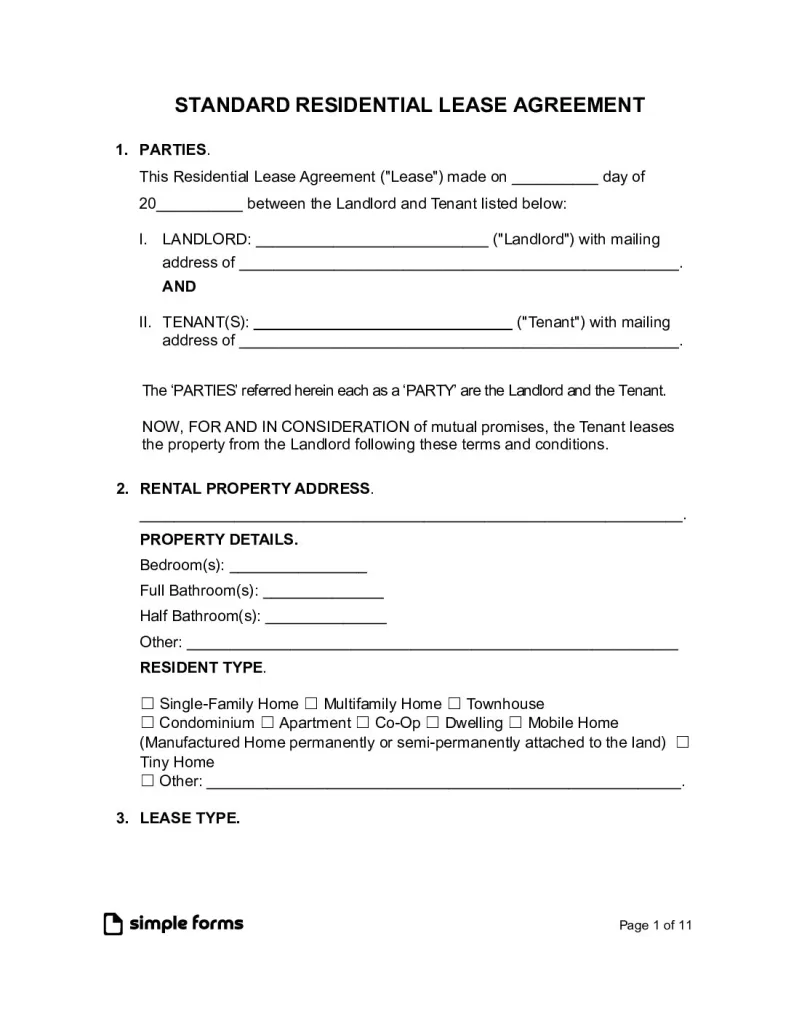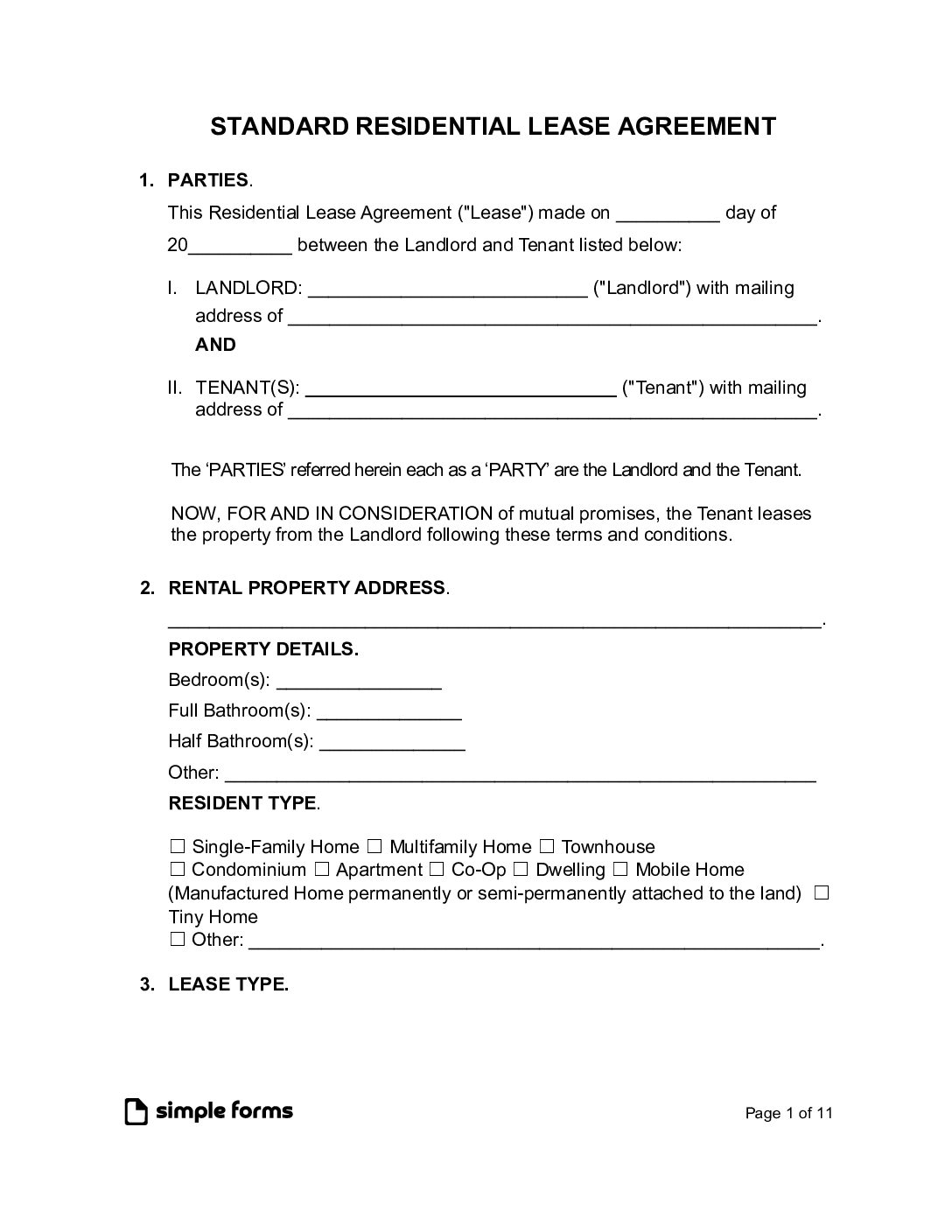A standard rental lease agreement is a written contract between the Landlord and Tenant. The agreement gives the Tenant(s) the right to occupy the property for a period of time in exchange for monthly rent payments.
Forms By State
- Alabama
- Alaska
- Arizona
- Arkansas
- California
- Colorado
- Connecticut
- Delaware
- Florida
- Georgia
- Hawaii
- Idaho
- Illinois
- Indiana
- Iowa
- Kansas
- Kentucky
- Louisiana
- Maine
- Maryland
- Massachusetts
- Michigan
- Minnesota
- Mississippi
- Missouri
- Montana
- Nebraska
- Nevada
- New Hampshire
- New Jersey
- New Mexico
- New York
- North Carolina
- North Dakota
- Ohio
- Oklahoma
- Oregon
- Pennsylvania
- Rhode Island
- South Carolina
- South Dakota
- Tennessee
- Texas
- Utah
- Vermont
- Virginia
- Washington
- Washington D.C.
- West Virginia
- Wisconsin
- Wyoming
Form Options By Type
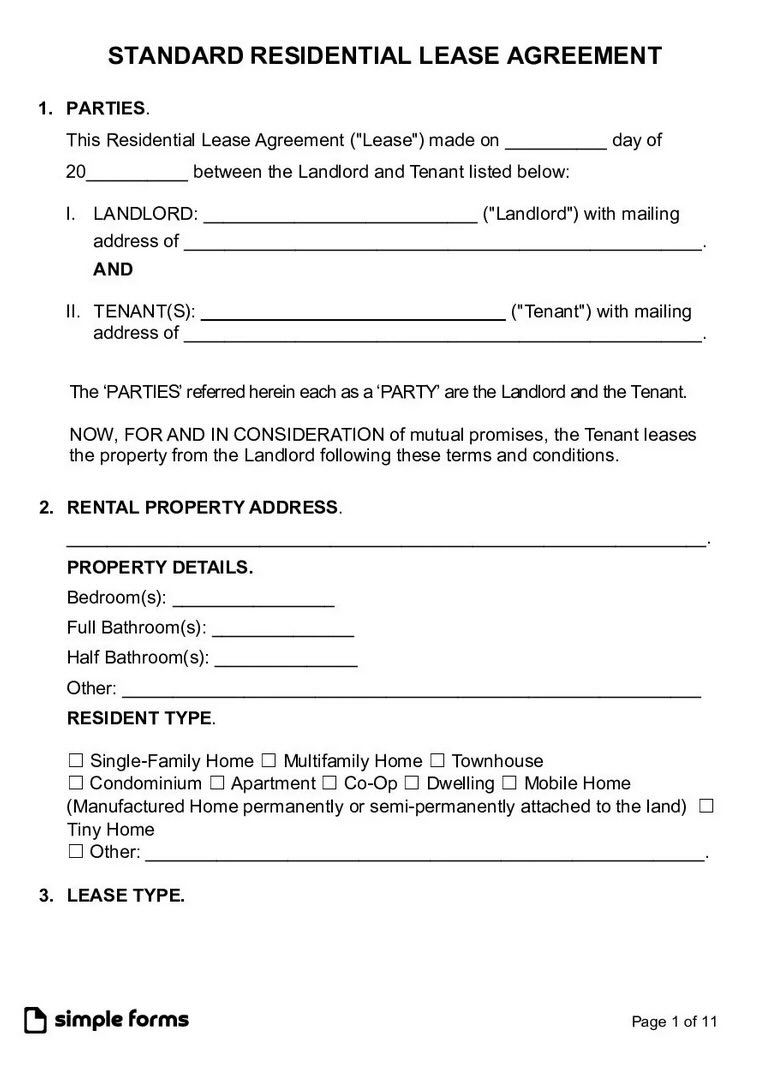 Standard Residential Lease Agreement Standard Residential Lease Agreement
Download: PDF |
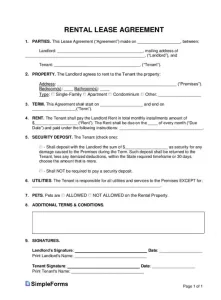 Simple (1-Page) Lease Agreement Simple (1-Page) Lease Agreement
Download: PDF |
Most Recent US Home Facts
- Population (2023): 334,914,895
- Median Households (2022): 125,736,353
- Median Household Income (2022): $75,149
- Owner-occupied Households (2022): 64.8%
Source: U.S. Census Bureau
How to Lease Your Residential Property: Simple Step-by-Step Options and Equipment Guide for Owners and Brokers (9 Steps)
Step 1 – Type of Lease
Landlords, Owners and Property Managers whom decide to rent out their unit(s) to Tenant(s) in exchange for rent payments need to first decide on the type of lease options they want to offer Tenants. The options include a short-term (seasonal), a long-term, or vacation lease agreement.
Agreement Types Depending on Lease Duration and Tenant Audience:
- Long-term lease – Minimum of one-year (12 months) or more. These Tenants typically are young professionals or family units where one needs to stay consistently in one geographic area to be close to a job or school for long periods of time.

- Short-term lease – Up to one-year (12 months) or for monthly (month-to-month). These Tenants tend to be college kids where they need to rent an apartment living space for 9 months out of the year before going home for summer vacation at parents house.

- Vacation lease – One-month (30 days) or less. These Tenants range in all different walks of life as one travels throughout their lifetime and it’s becoming more common especially after the pandemic where people work remotely and also study remotely online.

Step 2 – Preparing the Rental Property for Showings
Once the final decision is made on the lease type, the next step is to prepare the rental property for showings – in person and online. This step is when a cleaning company might help or a painter to fix interior and/or exterior touch ups. The plumber might also need to be contacted in case a faucet is leaking or a toilet is clogged!
A trip to Lowe’s or Home Depot might be a good idea for light bulbs, smoke detectors (including the compatible batteries), and having extra keys made (think extra keys for Lock-box, Brokers and Tenants).
Double check all of the essentials needed to make your home is 100% habitable prior to showing or posting any videos or pictures of the rental space online or in print ads..
Step 3 – Finding the Right Tenant(s)
The third step is finding and vetting potential Tenant(s). This is done by listing the property online, including entering information in the Multiple Listing Service (MLS). This may be the point where you will consider hiring a Real Estate Broker to help with the leasing process to avoid any financial or legal issues.
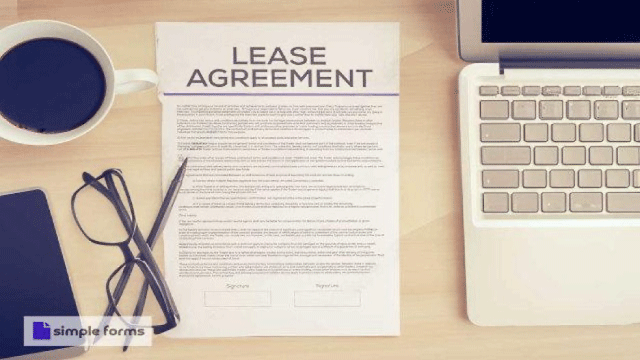
Advertising: Advertising rental properties depends on the local market and the target audiences. Landlords or property owners can choose from different advertising platforms, but it’s essential to be transparent about the property’s condition, updated photos, and prices to simplify the rental process. Also consider hiring a real estate agent to manage the rental process.
- High-end markets – Sotheby’s, Rent.com
- Middle-cost markets – Zillow, Redfin
- Low-budget markets – Craigslist

Step 4 – Preparing a Rental Application
A rental application serves to uncover three major concerns for an owner of property about a Tenant:
- Criminal history
- Credit history
- Previous evictions by prior landlords
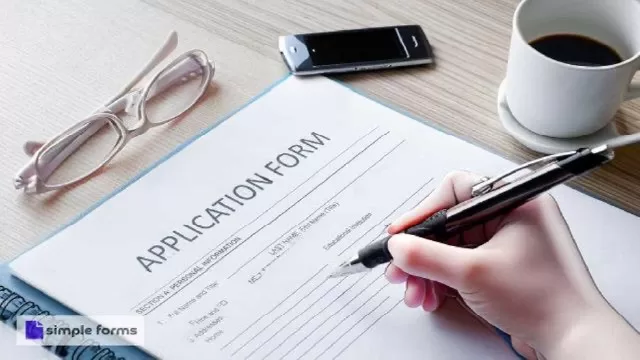
If a Tenant passes all three checks, then verify Tenants employment and means of paying rent. Landlords have the legal right to ask for government-approved identification, a social security number, and an applicant’s legal status.
Law Alert
The Fair Housing Act, 42 U.S.C. 3601, prohibits landlords and property owners from discriminating (denying) prospective tenants the ability to rent based on the following criteria:
- isability
- familial status or national origin
- race or color
- religion
- sex
Ways to Screen a Tenant:
- TransUnion SmartMove – TransUnion offers a tenant screening service called SmartMove. It allows landlords to request credit reports and criminal background checks on prospective tenants. SmartMove provides a credit-based recommendation that helps you assess the tenant’s financial stability and risk profile.
- Experian Connect – Experian offers a similar service called Experian Connect. Landlords can request credit reports and view a tenant’s credit history. This can help you gauge their creditworthiness and financial responsibility.
- Local Court Records – You can check your local court’s website or visit in person to search for eviction records, judgments, or any legal disputes involving prospective tenants. This can give you insight into their rental history and legal issues.
- Social Media and Online Searches – Conducting online searches and checking social media profiles can provide additional information about a tenant. While this isn’t an official screening method, it can give you an idea of their lifestyle, behavior, and any red flags.
Step 5 – Tenant Views the Space

Depending on the property owner, one may choose to require a rental application from the applicant either prior or after viewing the property. There could be disclosures you will need to offer each tenant before they view the property, depending on the state.
Law Alert: The most common disclosure required by the federal government is the Lead-Based Paint Disclosure, which requires owners of property built before 1978 to give prospective tenants a pamphlet (PDF).
Step 6 – Verify References
Landlords and property owners should be particular when asking for references from a prospective tenant. Asking of personal friends or family as references serves little use. There are no laws or limitations an owner must abide by when contacting references.
When asking for references, it’s best to ask for the following contacts:
- Previous and current employer;
- Prior landlord/owner of rented property.
Step 7 – Approving the Tenant

A landlord can approve a tenant for any reason. However, when it comes to rejecting a tenant from occupancy, the landlord must give the reason (which must be legal). A rejected application is due to a negative report on a credit report.
Law Alert
The Fair Credit Reporting Act requires property owners/landlords to disclose the information as to why a rental application was denied. Landlords must provide the denied applicant with the following:
- A written statement explaining the adverse facts
- A source of the reporting agency
Step 8 – Signing the Lease
Who Signs the Lease?
Leases can be signed online using services such as DocuSign or eSign. If the lease is signed in person, having the lease notarized is recommended. Property owners do not need to be named on the lease if a property management company controls the property. Verbal agreements are not legally binding.
- All persons who have applied to reside at the property;
- Owner or manager of property;
- If signing in person, a notary (public officer) is recommended.
Step 9 – Occupancy
The Tenant(s) have the right to occupy the property on the start date stated within the lease agreement unless otherwise written and agreed upon. Once the tenant has begun to occupy the property, the owner loses their right to enter it without proper notice. The lease agreement termination will be outlined in the agreement.
Landlord-Tenant Laws
Standard Rental Lease Security Deposits
Most U.S. states follow the rules set out by HUD, a department of the federal government that administers laws and regulations regarding housing.
- One months rent – Landlords are allowed to ask for a security deposit equal to 1 (one) month’s rent;
- Interest bearing account – Security deposits must be kept in a separate interest-bearing account;
- Unpaid Dues – The Landlord may use the security deposit as reimbursement for any unpaid dues when the lease expires;
- Refund – The landlord must return the security deposit in full within 30 days of notice;
Source: § 880.608 Security deposits.
How to fill out a rental lease agreement?
STEP 1 – The date on which both parties agree to the agreement.
STEP 2 – Landlord’s Name – If the landlord is a company, enter the company name.
STEP 3 – Landlord’s Address – The landlord’s street name and number.
STEP 4 – The landlord’s City, State, and Zip Code.
STEP 5 – The tenant’s full legal name that matches a government-issued ID.
STEP 6 – The tenant’s street name and number.
STEP 7 – The tenant’s current City, State, and Zip Code.
Definitions
Abandonment – The act of vacating the premises before fulfilling the terms of the agreement, without notice or consent, is abandonment.
Appraisal – An appraisal is a professional evaluation of the value of a property by a licensed appraiser.
Boilerplate Contract – Clauses in lease agreements that correlate critical legal points.
Closing Costs – Buyers and sellers typically incur various expenses beyond the property price to complete a real estate transaction. These expenses include fees for title insurance, legal services, and more.
Down Payment – The down payment in a real estate transaction is the first initial payment made by the buyer (Tenant) when purchasing a home. It is usually a percentage of the total purchase price.
Escrow – A third party of the Landlord and Tenant holds the funds until a transaction is completed.
EBay – The eBay Website is helpful for rental properties with selling/buying items/furniture online.
Landlord and Tenant – The landlord agrees to let the tenant use the property for a specified period in exchange for rent.
Lease Agreement vs. Rental Agreement – A lease agreement is usually for long lease contracts, 6 months or more, and a rental agreement is usually for short-term leases of 30 days.
Property Rentals – Real Estate assets that are owned by individuals or entities (businesses) that are rented out to Tenants/Occupants for a specific period of time in exchange for rent payments.
Connecting with Clients Online Via Zoom
Rental Deliveries
Set up USPS Informed Delivery for rental properties, where you can change your mailing address temporarily and see photos of mail and packages before they arrive.
FAQs
Q. What is a Rental Agreement Form?
A. A rental agreement is a contract that lasts a month and is similar to a lease in many ways. It’s different from a lease in that it is automatically renewed.
Q. How do you get out of a lease agreement?
A. Laws are in place that override the the lease agreement where the tenants can break the contract.
Q. How do you spot a fake lease agreement?
A. Some lease agreements are fake; here are the top ways to spot one: the landlord asks for a large deposit, the landlord puts time pressure on you to sign the agreement, and the lease agreement does not allow you to legally get out of the lease respectfully.
Q. How to make a fake lease agreement?
Although we highly discourage creating a fake lease agreement, download our template above and fill in the blanks unless used for educational purposes.
Q. Where can I find visual guides for renting property?
Q. What are the 2024 Fannie Mae Selling and Renting Updates?
A. Fannie Mae’s tools and resources are available free, including the 2024 selling guide PDF.
Q. How to cancel a lease agreement?
A. Landlords usually require a 30-day notice, although it’s best to check with local laws and your lease agreement. The lessor and lessee MUST sign a letter stating the cancellation.
Q. How to become a real estate agent?
A. Review our guide.
Q. Where can Tenants find local guides near Rental Property?
Q. What is a triple-net lease agreement?
A. The tenant agrees to pay for ALL expenses/bills of the rental property, including taxes, insurance, and maintenance.
Q. Where can I download an Ontario Residential Lease Agreement?
A. Access the Ontario Standard Lease Agreement Free Templates in PDF and Microsoft Word formats by clicking the buttons on the page.
Q. Who is Responsible for Maintenance and Repairs?
A. Landlord Responsibilities: structural repairs, maintenance of common areas, and fixing significant systems like HVAC, plumbing, and electrical.
Q. Where can I find the Commercial Lease Agreement?
A. Commercial Lease Agreement Free Download
Lease Agreement Sample
